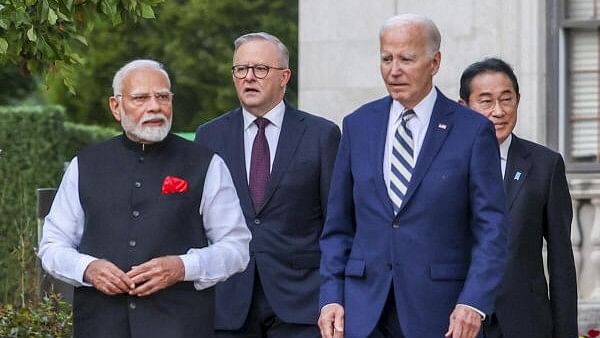
President Joe Biden, Prime Minister Narendra Modi, Australia's Prime Minister Anthony Albanese and Japan's Prime Minister Fumio Kishida at the Quad Leaders Summit at Archmere Academy in Claymont, Delaware, USA.
Credit: PTI Photo
The Quad summit held in the US signalled an all too apparent shift in how this grouping of four democracies – Australia, India, Japan and the US – sees itself as a “force for global good”. The Quad has thus far projected itself as a non-security grouping and shied away from identifying China as its target, mainly thanks to India. Hence the emphasis on public health, disaster response, and digital public infrastructure in the developing world – being “in competition, not conflict, with China”. But starting with a cybersecurity initiative and cooperation on maritime domain awareness and plans to counter illegal fishing in the Indo-Pacific region at the Tokyo summit last year, the Quad has taken baby steps toward securitisation of the grouping. At Wilmington -- outgoing US President Joe Biden’s hometown -- last weekend, it took a further step with a coast-guard cooperation plan, including a Quad-at-Sea Ship Observer Mission in 2025 to improve “interoperability”. Also launched was a Indo-Pacific Logistics Network pilot project “to pursue shared airlift capacity among the four nations and leverage collective logistics strengths”. The stated aim is to support response to natural disasters. It will clearly involve Quad military transporters and personnel operating together.
At the summit, Prime Minister Narendra Modi reiterated that the Quad's priority is a “free, open, inclusive and prosperous Indo-Pacific” with a “rules-based international order, respect for sovereignty, territorial integrity, and peaceful resolution of all issues”. “We are not against anyone,” he said, though this boilerplate formulation is a reference to Chinese belligerence in the South China Sea and beyond. Modi also stated that the “Quad is here to stay”. There are multiple messages, some for the Quad partners themselves, to read into the fact that Modi felt the need to make that declaration. That his National Security Adviser Ajit Doval could not accompany him on this visit sent its own message on the state of the Modi government’s ties with the Biden administration in the wake of the court summons issued in the US in the Panun case. But Beijing was quick to read the message meant for it, and has lashed out at the US for “pooling together countries to muster military and security cooperation…to contain China”.
What of India's own problems with China? External Affairs Minister S Jaishankar said recently that the disengagement at the border is “75%” accomplished, and that the militarisation on the border was the bigger issue. The 2024 Economic Survey floated the idea of increasing FDI from China to help increase India's global supply chain participation. India's mostly import-driven trade with China is hitting higher notes every year. Even as Delhi gets drawn willy-nilly deeper into the Indo-Pacific, it has the difficult challenge of defining its own China policy on a surer footing.